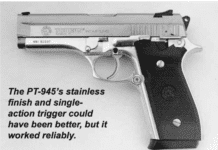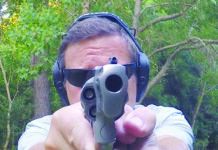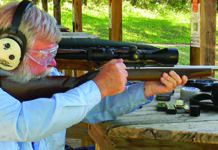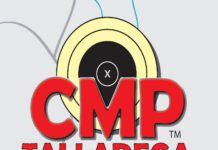Re “A Few Odd Things for Glock’s 21,” January 2014
Your character assassination of Scherer extended 45 ACP magazines seems to fail to follow the Gun Tests claim that Gun Tests does its own homework before reporting to subscribers. You found an unmarked 45 ACP extended magazine. Where? And does Gun Tests routinely evaluate unmarked items? Then you irresponsibly stated, “Similar magazines are sold under the Scherer name, but we can’t verify this was one of those.” Many-to-most readers will only remember that Scherer 45 ACP extended magazines received a Gun Tests Grade: F. Why review, evaluate and grade something that even you do not know where it came from and/or who manufactured it?—Gary A Weaver,
DVM, PhD, Esq
McLean, Virginia
The magazine came with the gun as our FFL bought it. So we didn’t have a clam box to verify who made the magazine. But in our testing of the Glock, we found the mag didn’t work. So we think it was worth warning our readership that an extended magazine should be examined carefully. You figured out that our unmarked sample wasn’t a Scherer, and we’d guess everyone else did, too, since yours was the only letter we received on the topic.
For those who want to research these magazines further, log on to Midway.com, search for product #133506, and read the user comments on the Scherer Glock 25 round magazine (discontinued).
Likewise, we’d suggest you go to CheaperThanDirt.com, search for product #7-SGM4527, the SGM Tactical Glock 21 45 ACP 27-Round Extended Magazine ($23.71).
Irrespective of maker, however, the great mass of bullets in such a fully loaded magazine tends to pull it out of the gun on recoil. With the slightest flaw in the locking latch within the Glock or on the magazine, the magazine will very easily come out of the gun. The notches on my nearly new Glock plastic magazines are already starting to show rounding-over from simple insertion. The fully loaded 27-round magazine contained 1.25 pounds of ammo, plus the weight of the magazine, all suspended by a small plastic notch into which a plastic retainer bites approximately 0.070 inch deep by about 0.2 inch to 0.3 inch long. While it might work for a while, the whole concept is basically a recipe for failure, no matter who makes the magazines. — Ray Ordorica
Re “Shooting the Rossi Circuit Judge,” January 2014
Really enjoyed the test of the Circuit Judge. Here in Indiana, our rifle choices for deer hunting are severely restricted. We can only deer hunt with rifles with bullet diameters of at least .357 and brass no longer than the 460 S&W magnum. This means mostly Encores, H&R’s in 44 Magnum and lever guns in 44 Magnum. The accuracy of the Circuit Judge in 45 LC or .410 slugs didn’t sound good enough for most of us here. However, many Hoosiers are wondering how the Circuit Judge in 44 Mag stacks up accuracy wise. With the 45 LC’s long jump to reach the rifling, it probably can’t reach the accuracy potential of the gun. The shorter cylinder of the 44 Magnum might achieve the 1- to 1.5-inch groups the H&R’s can produce.
— Mike Frye
I noticed that you did not test the Hornady 300-grain HP-XTP #45230. I load it in my old 7.5-inch Vaquero over 20 grains of H110 for a muzzle velocity of 1100 fps and about 800 foot-pounds at the muzzle. I wonder what you could get using slower powders out of that 18.5-inch barrel?
— David L. Berry
Re “Suppressor-Ready Plinking 22s: Ruger, Smith & Wesson, Walther,” February 2014
Dear Todd: I am a long-term subscriber to Gun Tests, and I value your tests, observations, and recommendations. I am 71 years young, left handed, do not have extreme strength in upper extremities to rack a heavy slide, and am somewhat recoil sensitive.
I am looking for advice/recommendations on a 22-caliber automatic pistol. I would like to have something relatively accurate, no more than 22 to 25 ounces of weight, a slide that is fairly easy to rack, is relatively easy to take apart and reassemble for easy cleaning, an excellent trigger, and no more than $500 new.
In the past, you have reviewed the Ruger 22/45 and the Walther P22, which you have rated highly, but I do not know if these two meet all of my objectives.
Ruger is coming out with a new 22/45 Lite in February. I do not know if you have heard or read anything on this yet. I have read where you need to be a mechanical engineer and a master gunsmith to take the older ones apart for cleaning and put back together. I would appreciate your help in this endeavor.
—John Gantt
Hey John: Check the February issue and see if any of the three guns reviewed there fit your needs. I’d think any of them would work, since they all had low slide-retraction effort. But the M&P22 might be the best bet, since it’s full-size and ambi. No problems with it either. Let me know once you’ve had a chance to read that story. [Note: Mr. Gantt later replied, “I agree with you. The M&P22 is the best choice for my needs.”] — Todd Woodard
Re “Firing Line,” January 2014
Gun Tests is a magnificent, no-BS magazine. Just what many of us want when looking for information on firearms. Kudos to you and your personnel.
Bob Feierabend wrote you about his difficulty in retracting the slide on many pistols. One type of pistol that he might consider is the tip-up barrel style. With this pistol, the barrel is locked to the pistol frame, and with the press of a lever, is released at the breech end and tips up, being hinged at the muzzle end. This exposes the chamber for loading and unloading a cartridge. This style pistol is made by Beretta and Taurus, and comes chambered in 22 LR, 25 ACP, 32 ACP, and 380 ACP.
These are straight blowback pistols, and the recoil of the 380 chambering would probably be too stout for arthritic hands. Also in the small calibers are the locked-breech pistols made by Kel-Tec and others. These are fairly easy to retract the slide on. You’ll probably receive a lot of letters with helpful advice for Mr. Feierabend, but I wanted to make sure that he knew the information is available. Thank you for a great magazine.— D. Kulback
Bloomingdale, Ohio
Mr. Kulback: Super advice. Thank you. Reader John Ashjian of San Antonio added, “I received the Feb 2014 issue today and found the letter on slide retraction effort interesting, since I also have arthritis and find it difficult to retract the slide. I don’t know how many tilt-barrel handguns are out there, but I’d like to suggest you do an article on them. That’s one answer to lack of handgun strength while using a slim concealable pistol versus a revolver.” — tw
I enjoyed your article on the Ruger 22/45 Paclite. Your experiences echo my own, with the exception that I quickly swapped the trigger and rear sight for Volquartsen parts, which I think make that little pistol about perfect. I could not find any Paclite versions of this firearm for sale; Davidson’s has a stock of the fluted barrel 22/45 Lite version. Maybe time to order a Sparrow.
— Mark Forster
Re “Two Big 45 ACP Pistols: Glock 21 Versus Ruger’s SR45,” December 2013
The December 2013 of Gun Tests issue compares the G21 to the SR45, and I was eager to see how my former polymer 45 pick ranked against my current favorite. I was surprised to read that your example of the SR45 was unreliable, as this has not been the case with mine in over a thousand rounds of mixed brands, but no Winchester BEB that I recall. I contacted the manufacturer, and they have no pending advisories or recalls on any serial number range for that model.
The criticism of the magazine disconnect within the article is illogical. The SR45 is designed with a magazine disconnect “safety” to prevent firing when no magazine is present, as per page 18 on the manual. While I am not a fan of this feature, it is designed into the function of the weapon, so should not be a point of criticism unless it is factored in as a subjective or opinion sidebar. This may be a required feature for sales in some areas such as California and Massachusetts.
Additionally, dry firing without the magazine inserted can (eventually will) cause striker and magazine disconnect issues. This is true for the SR series and not just the SR45. It sounds like there could be an issue with the test sample striker/spring, and it should be returned to the manufacturer for repair under their warranty coverage. Mr. Ordorica should read the instruction manual, provided free of charge, with the weapon and available online for further clarification on the proper operation of the SR45.
I also find fault with another subjective knock against the SR45 for use of the slide-stop mechanism. Notice that, as per the instruction manual, the operation of the slide stop is intended to hold the slide in a rearward position and to release, the slide is manipulated rearward then released forward under spring pressure. The notion that operators with “serious training” manipulate a slide-stop lever to strip a new round into the chamber upon magazine changes is subjective and by no means representative of all “serious” trained shooters. I agree that some practitioners prefer to operate a slide release manually to chamber a round and, in my SR45, this is possible with moderate thumb pressure. However, more than a few individuals share my view that simplicity and consistency are key to survivability, especially if you run different makes and models of pistols, so the slingshot method is preferred. I would also submit that in a personal-defense scenario, my training says to avoid running the weapon dry, if possible, by inserting a full magazine during lulls in the action, thus avoiding the need to choose between either method of releasing a locked slide.
I do appreciate the work your team does and hope that my comments will be considered carefully for any opportunities to improve upcoming issues. I believe you and the staff are capable of better writing and objectivity than this article demonstrated.
I will be re-testing my carry load of Gold Dot HPs for peace of mind and Winchester BEB 185 (for curiosity) on my next trip to the range. If it is, in fact, an ammunition sensitivity, this is important to know, and I appreciate the warning. I suspect the new less-toxic primer as a contributing factor, if confirmed.— B. Starnes
The test Ruger SR45 was received NIB from a distributor and transferred directly to me with only minor handling, by one of our FFLs. Of course, he does not go around dry-firing his guns to the point of destruction. Nor do I.
We went looking for the source of the problems with the gun only after it failed to fire. As such, it didn’t work and ought never to have left the factory in that condition. Ruger does not have a habit of sending out faulty firearms. When one comes along, we flag it. — Ray Ordorica
Just a question here. In your December issue, you rated the Ruger SR45 an F because it did not “go bang.” That’s okay, but I was wondering how one gun can flunk your evaluation, and in the same month, it gets a very positive article in American Rifleman. I really enjoy your evaluations and trust them most of the time, but I think maybe this is a bit vindictive against a fine company with a fine reputation Ruger. I know I have read positive articles in Gun Tests about Taurus products and in my opinion (after owning two Taurus revolvers 30 years apart), I would never own another Taurus. I think any gun enthusiast would agree that Ruger, for the most part, has always turned out a very good product.
—James Hewitt
Lexington, North Carolina
We report what we find. I’m unaware of any gun American Rifleman has rated negatively. They may have, but I’m just not aware of it. Please let me know if you recall one, and I’ll go look it up.
For our part, if a gun malfunctions, it’s up to the writer and his team to grade it accordingly. There’s a lot of judgment that goes into that decision. We don’t rate a gun an F lightly. We often can’t diagnose why a gun fails during the initial test.
We’re interested in the “why” when a gun fails, but only if reasonable attempts to solve the problem work. So we report the failures.
From our testing perspective, a manufacturer’s previous record of producing good, or bad, guns doesn’t factor in. It either goes bang or it doesn’t. It’s not vindictive at all.
This particular Ruger pistol is being assessed locally by a gunsmith at Full Armor Firearms to determine
what’s causing the problem. They will attempt to repair it, document that, and cost out the repair. But that doesn’t change the initial failure.
I would like to thank Gun Tests Readers Mike Stone, Chris Boyer, Michael Williams, and Tom Young for additional comments about the story. — tw
M14/M1A Rifle Tests
I notice a review of a Springfield M1A Loaded is scheduled. Is there any thought on a review of the other lesser-known makers, such as LRB of Long Island, 7.62mm Firearms Rifles, or James River Armory? The use of forged receivers as well as the overall appearance/function of the rifles would be of particular interest.
—Bruce Phillips
A good idea, which I’ve forwarded to a writing team and FFL. — tw




























